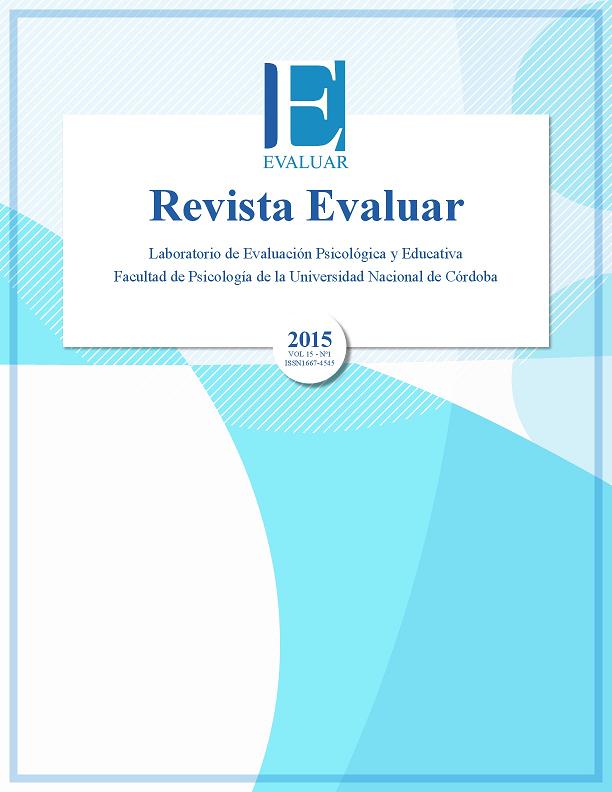The Achievement Emotions Questionnaire-Argentine (AEQ-AR): internal and external validity, reliability, gender differences and norm-referenced interpretation of test scores
DOI:
https://doi.org/10.35670/1667-4545.v15.n1.14908Palabras clave:
emoción de logro, ansiedad ante los exámenes, teoría de control-valor, cuestionario, medición, españolResumen
Este artículo informa la confiabilidad, validez interna, validez externa, diferencias de género y normas de una versión española del Achievement Emotions Questionnaire (Pekrun et al., 2011) adaptada para estudiantes universitarios de Argentina (AEQ-AR). El AEQ-AR consta de 24 escalas que miden disfrute, esperanza, orgullo, alivio, enojo, ansiedad, vergüenza, desesperanza y aburrimiento en clase, al estudiar y realizar exámenes. Participaron del estudio estudiantes argentinos que estudiaban en la Universidad Nacional de Córdoba. Se conformaron una muestra de estimación (N = 400) y una muestra de confirmación (N = 266) para examinar la validez interna y la confiabilidad. La muestra total (N = 666) se utilizó para analizar la validez externa, las diferencias de género y obtener las normas para las escalas. Los resultados indican que las escalas son confiables, validas internamente como lo demostraron los análisis factorial exploratorio y confirmatorio, y validas externamente en términos de relaciones con valor de la tarea, autoeficacia social académica, metas de logro y rendimiento académico. Además, se encontró apoyo parcial para la hipótesis de diferencias de género de las emociones prospectivas y retrospectivas relacionadas a resultados negativos. Las normas obtenidas para estudiantes hombres y mujeres permitirán interpretar las puntuaciones obtenidas para propósitos prácticos. Finalmente, se presentan en el apéndice las instrucciones y escalas del AEQ-AR.
Descargas
Citas
Arias, B. (2008). Desarrollo de un ejemplo de análisis factorial confirmatorio con LISREL, AMOS y SAS. Seminario de Actualización en Investigación sobre Discapacidad SAID 2008. Universidad de Valladolid.
Artino Jr., A. R., & Jones II, K. D. (2012). Exploring the complex relations between achievement emotions and self-regulated learning behaviors in online learning. Emotions in Online Learning Environments, 15(3), 170–175. doi:10.1016/j.iheduc.2012.01.006
Bandalos, D. L. (2002). The Effects of Item Parceling on Goodness-of-Fit and Parameter Estimate Bias in Structural Equation Modeling. Structural Equation Modeling: A Multidisciplinary Journal, 9(1), 78–102. doi:10.1207/s15328007sem0901_5
Cassady, J. C., & Johnson, R.E. (2002). Cognitive test anxiety, procrastination, and academic performance. Contemporary Educational Psychology, 27, 270-295.
Cattell, R. (1966). The Scree Test for the number of factors. Multivariate Behavioral Research, 1, 141–161.
Daniels, L. M., Stupnisky, R. H., Pekrun, R., Haynes, T. L., Perry, R. P., & Newall, N. E. (2009). A longitudinal analysis of achievement goals: From affective antecedents to emotional effects and achievement outcomes. Journal of Educational Psychology, 101, 948–963.
Elliot, A. J., & Murayama, K. (2008). On the measurement of achievement goals: Critique, illustration, and application. Journal of Educational Psychology, 100, 613–628.
Fabrigar, L. R., Wegener, D. T., MacCallum, R. C., & Strahan, E. J. (1999). Evaluating the use of exploratory factor analysis in psychological research. Psychological Methods, 4(3), 272-299.
Ferrando, P., Verea, M., & Lorenzo, U. (1999). Evaluación Psicométrica del Cuestionario de Ansiedad y Rendimiento en una muestra de escolares. Psicothema, 11(1), 225–236.
Frenzel, A. C., Thrash, T. M., Pekrun, R., & Goetz, T. (2007). Achievement emotions in Germany and China: A cross-cultural validation of the Academic Emotions Questionnaire-Mathematics (AEQ-M). Journal of Cross-Cultural Psychology, 38, 302–309.
George, D., & Mallery, P. (2007). SPSS for Windows: Step by step 14.0 update (7 ed.). Boston: Allyn & Bacon.Goetz, T. (2004). Emotionales Erleben und selbstreguliertes Lernen bei Schülern im Fach Mathematik [Students emotions and self-regulated learning in mathematics]. Munich, Germany: Utz.
Goetz, T., Pekrun, R., Hall, N., & Haag, L. (2006). Academic emotions from a social-cognitive perspective: antecedents and domain specificity of students’ affect in the context of Latin instruction. British Journal of Educational Psychology, 76(2), 289-308. doi:10.1348/000709905X42860
González, A., Paoloni, V., & Rinaudo, C. (2013). Aburrimiento y disfrute en clase de Lengua española en secundaria: predictores motivacionales y efectos sobre el rendimiento. Anales de Psicología, 29(2), 426-434. doi:10.6018/analesps.29.2.136401
González Fernández, A., Donolo, D., & Rinaudo, M. C. (2009). Emociones académicas en universitarios: su relación con las metas de logro. Ansiedad y Estrés, 15, 263-277.
Heredia, D., Piemontesi, S., Furlán, L., & Hodapp, V. (2008). Adaptación del Inventario Alemán de Ansiedad frente a los Exámenes (GTAI-A). Evaluar 8, 46-60.
Horn, J. L. (1965). A rationale and test for the number of factors in factor analysis. Psychometrika, 30(2), 179-185.
Hoyle, R., & Panter, A. (1995). Writing about structural equation models. In R. Hoyle (Ed.), Structural equation modeling: Concepts, issues, and applications(pp. 100–119). Thousand Oaks, CA: Sage
Ismail, N. M. (2015). EFL Saudi Students’ Class Emotions and Their Contributions to Their English Achievement at Taif University. International Journal of Psychological Studies, 7(4), 19-42. doi:10.5539/ijps.v7n4p19
Kaiser, H. F. (1960). The application of electronic computers to factor analysis. Educational and Psychological Measurement, 20, 141-151.
Karabenick, S. A., Woolley, M. E., Friedel, J. M., Ammon, B. V., Blazevski, J., Ree Bonney, C., et al. (2007). Cognitive processing of self-report items in educational research: Do they think what we mean? Educational Psychologist, 42, 139–151.
Kim, J. R., & Lee, E. (2014). The validation of the Korean version of the Achievement Emotions Questionnaire-Mathematics (K-AEQ-M) for middle school students. The Korean Journal of Human Development, 21, 115–139.
King, R. B. (2010). What do students feel in school and how do we measure them?: Examining the psychometric properties of the S-AEQ-F [Short-Academic Emotions Questionnaire-Filipino]. Philippine Journal of Psychology, 43, 161–176.
Kondo, D. S. (1997). Strategies for coping with test anxiety. Anxiety, Stress, and Coping, 10, 203-215.
Lichtenfeld, S., Pekrun, R., Stupnisky, R. H., Reiss, K., & Murayama, K. (2012). Measuring students’ emotions in the early years: The Achievement Emotions Questionnaire-Elementary School (AEQ-ES). Learning and Individual Differences, 22, 190–201.
Merenda, P. (1997). A guide to the proper use of Factor Analysis in the conduct and reportingof research: pitfalls to avoid. Measurement and evaluation in counseling and evaluation, 30, 156-163.
Molfenter, S. (1999). Prüfungsemotionen bei Studierenden [Test emotions in university students]. Unpublished dissertation, Institute of Psychology, University of Regensburg, Germany.
Mouratidis, A., Vansteenkiste, M., Lens, W., & Auweele, Y. V. (2009). Beyond positive and negative affect: Achievement goals and discrete emotions in the elementary physical education classroom. Psychology of Sport and Exercise, 10, 336–343.
Olaz, F. (2006). Construcción de una escala de autoeficacia para estudiantes universitarios. Comunicación presentada en el primer encuentro nacional de Evaluación Psicológica y Educativa, Universidad Nacional de Córdoba.
Paoloni, P. V., Vaja, A. B.,& Muñoz, V. L. (2014). Reliability and Validity of the Achievement Emotions Questionnaire. A Study of Argentinean University Students. Electronic Journal of Research in Educational Psychology, 12(3), 671-692.
Peixoto, F., Mata, L., Monteiro, V., Sanches, C., & Pekrun, R. (2015). The Achievement Emotions Questionnaire: Validation for Pre-Adolescent Students. European Journal of Developmental Psychology, 12, 472-481. doi:10.1080/17405629.2015.1040757
Pekrun, R. (2006). The control-valuetheory of achievement emotions: Assumptions, corollaries and implications for educational research and practice. Educational Psychology Review, 18, 315–341.
Pekrun, R., & Bühner, M. (2014). Self-report measures of academic emotions. In R. Pekrun & L. Linnenbrink-Garcia (Eds.), International handbook of emotions in education (pp. 561-579). New York, NY: Taylor & Francis.
Pekrun, R., Elliot, A. J., & Maier, M. A. (2006).Achievement goals and discrete achievement emotions: A theoretical model and prospective test. Journal of Educational Psychology, 98, 583–597.
Pekrun, R., Elliot, A. J., & Maier, M. A. (2009). Achievement Goals and Achievement Emotions: Testing a Model of Their Joint Relations With Academic Performance. Journal of Educational Psychology, 101, 115–135.
Pekrun, R., Goetz, T., & Perry, R. P. (2005). Achievement Emotions Questionnaire (AEQ) -User’s manual. Munich, Germany: University of Munich, Department of Psychology.
Pekrun, R., Goetz, T., Daniels, L. M., Stupinsky, R. H., & Perry, R. P. (2010). Boredom in achievement settings: exploring Control-Value antecedents and performance outcomes of a neglected emotion. Journal of Educational Psychology, 102(3), 531-549. doi:10.1037/a0019243
Pekrun, R., Goetz, T., Frenzel, A. C., Barchfeld, P., & Perry, R. P. (2011). Measuring emotions in students’ learning and performance: the achievement emotions questionnaire (AEQ). Contemporary Educational Psychology, 36, 36-48.
Pekrun, R., Goetz, T., Titz, W., & Perry, R. P. (2002). Academic emotions in students’ self-regulated learning and achievement: A program of quantitative and qualitative research. Educational Psychologist, 37, 91–106. doi:10.1207/S15326985EP3702_4
Pekrun, R., & Perry, R. P. (2014). Control-value theory of achievement emotions. In R. Pekrun & L. Linnenbrink-Garcia (Eds.), International handbook of emotions in education (pp. 120–141). New York: Taylor & Francis.
Pérez, C. J. M. (2007). Manual de Usuario de la plataforma de encuestas en línea: Lime Survey, Versión 1.0, Licencia de Documentación Libre GNU.
Pérez, E., & Medrano, L. (2014). Exploratory factor analysis: conceptual and methodological basis. Revista Argentina de Ciencias del Comportamiento, 6(3), 71-80.
Pérez, E., Medrano, L., & Sánchez-Rosas, J. (2013). El pathanalysis: conceptos básicos y ejemplos de aplicación. Revista de la Asociación Argentina de Ciencias delComportamiento, 5, 52-66.
Pintrich, P. R., Smith, D. A. F., Garcia, T., & McKeachie, W. J. (1993). Reliability and predictive validity of the motivated strategies for learning questionnaire (MSLQ). Educational and Psychological Measurement, 53, 810–814.
Sánchez-Rosas, J. (2011). Cómo evaluar las emociones académicas. Adaptación del Cuestionario de Emociones de Logro. III Congreso de Psicología de la Facultad de Psicología de la Universidad Nacional de Córdoba. doi: 10.13140/2.1.3400.4484
Sánchez-Rosas, J. (2013). Academic help-seeking, social academic self-efficacy and class-related emotions in university students. Revista de la Asociación Argentina de Ciencias del Comportamiento, 5(1), 35-41.
Sánchez-Rosas, J. (2015). Validation of the Achievement Goal Questionnaire –Revised in Argentineanuniversity students (A-AGQ-R). International Journal of Psychological Research, 8(1), 10-23.
Sánchez-Rosas, J., & Bedis, J. (2015). Measuring Strategies to Cope with Boredom in Spanish Speaking Population: A Study with Argentinian University Students. Evaluar, 15, 99-122.
Sánchez-Rosas, J., & Pérez, E. (2015). Measuring threats, benefits, emotional costs and avoidance of academic help seeking in Argentinian university students. Pensamiento Psicológico,13(2), 49-64. doi:10.11144/Javerianacali.PPSI13-2.mtbe
Sánchez-Rosas, J., Piotti, A., Sánchez, V., Pereira, A., & Debat, E. (2011). Implicancias del interés, la importancia y la utilidad de los materiales y contenidos de aprendizaje para las emociones académicas. Presented at the III Congreso de Psicología de la Facultad de Psicología de la Universidad Nacional de Córdoba, Argentina. doi:10.13140/2.1.4317.9526
Sánchez-Rosas, J., Takaya, P. B., & Molinari, A. V. (2016). The Role of Teacher Behavior, Motivation and Emotion in Predicting Academic Social Participation in Class. Pensando Psicología, 12(19), 39-53. doi: http://dx.doi.org/10.16925/pe.v12i19.1327
Sánchez-Rosas, J., Takaya, P. B., & Molinari, A. V. (2016). Atención en clase: rol predictivo del comportamiento docente, valor de la tarea, autoeficacia, disfrute y vergüenza. Psiencia. Revista Latinoamericana de Ciencia Psicológica.
Spangler, G., Pekrun, R., Kramer, K., & Hofmann, H. (2002). Students’ emotions, physiological reactions, and coping in academic exams. Anxiety, Stress and Coping, 15, 383-400.
Titz, W. (2001). Emotionen von Studierenden in Lernsituationen [Students’ emotions in situations of learning]. Muenster, Germany: Waxmann.
Zeidner, M. (1998). Test anxiety: the state of the art. New York: Plenum.
Descargas
Publicado
Cómo citar
Número
Sección
Licencia
Derechos de autor 2015 Javier Sánchez Rosas

Esta obra está bajo una licencia internacional Creative Commons Atribución 4.0.
Revista Evaluar aplica la Licencia Internacional de Atribuciones Comunes Creativas (Creative Commons Attribution License, CCAL). Bajo esta licencia, los autores retienen la propiedad de copyright de los artículos pero permiten que, sin que medie permiso de autor o editor, cualquier persona descargue y distribuya los artículos publicados en Evaluar. La única condición es que siempre y en todos los casos se cite a los autores y a la fuente original de publicación (i.e. Evaluar). El envío de artículos a Evaluar y la lectura de los mismos es totalmente gratuito.




_(3).jpg)



.jpg)



